The image of the Little Insurgent moves you to tears? Why then, when you see a black toddler with a gun, you say barbarism?
It is impossible to count how many children took part in the Warsaw Uprising, just as it is impossible to determine how many small soldiers were killed. One thing is certain, however - the participation of the little ones in the fights had to be common.
Children with rifles
Wojciech Bąk mentions Little boys in short funny shorts - great intelligence agents, and even soldiers and Kazimierz Brandys told the story of a certain "Orzel" - a six-year liaison officer,
(…) a person with an upturned nose, who was playing Indians on Solec Street in July, was officially declared a participant in the world war for peace in August. But his family relations did not change because of that:in front of the platoon he got a skin from his mother for his willful participation in a nighttime assault .
Kazimierz Leski "Bradl", one of the commanders of the "Miłosz" battalion, admired after the war the teamwork in which people fought from the twelfth (a certain> Mirek <) to the age of 50 . So it can be safely assumed that a child was found in every second insurgent platoon .
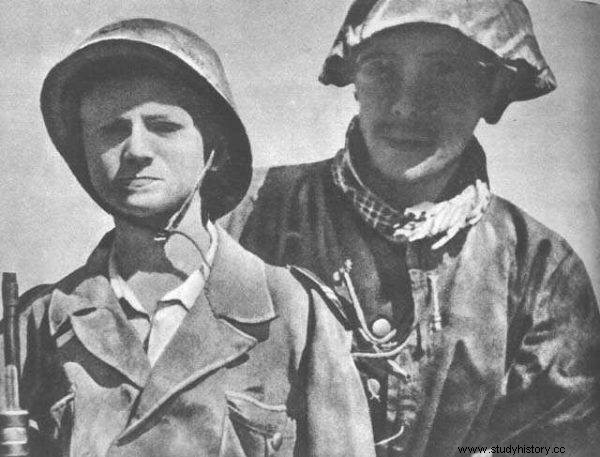
Witold Modelski ps. "Warszawiak" (on the left), 12-year-old participant in the Warsaw Uprising
Just a few years before the outbreak of the uprising, the head of the Gray Ranks, Florian Marciniak "Nowak", after long talks with Emil Fieldorf "Nile", adopted the following division of tasks:children aged 14-16 will form groups of the so-called "Zawiszaks" dealing with distribution and communication and to a lesser extent intelligence.
Their slightly older colleagues, under the age of 18, organized in so-called Combat Schools, were to do more or less the same, but extended to basic military training. Adult scouts formed the Assault Groups - outstanding, it is worth adding. It was from them that the famous "Umbrella" was formed, known, for example, from the action at the Arsenal or the execution of the sentence on Kutscher.
Children want to fight!
Either way, two things were clear to the command. First of all, the participation of children in the conspiracy cannot be avoided. Secondly, everything should be done to prevent children from coming into contact with weapons as long as possible. As for the first assumption, it was very realistic.
Despite the bans, children would get caught up in underground activities . Irena Łukomska "Dziembowska", commander of the Warsaw-South Military Social Service, later recalled:
I ran a boarding house for girls from 13 years of age during the war (...) I myself had to look for conspiratorial contacts for these children, from sabotage to distribution, because otherwise they would have tried to get into underground work on their own .
And Jolanta Mirosława Zawadzka-Kolczyńska "Klara", a liaison officer in the "Chrobry II" group, talked about a certain "Pestka" - an eleven-year-old boy who persuaded the commander to admit him to the unit with the words: Well, my brothers are fighting, it's me I want too! In turn, Kamila Merwatowa, a nurse from the Old Town, recalled such a picture:
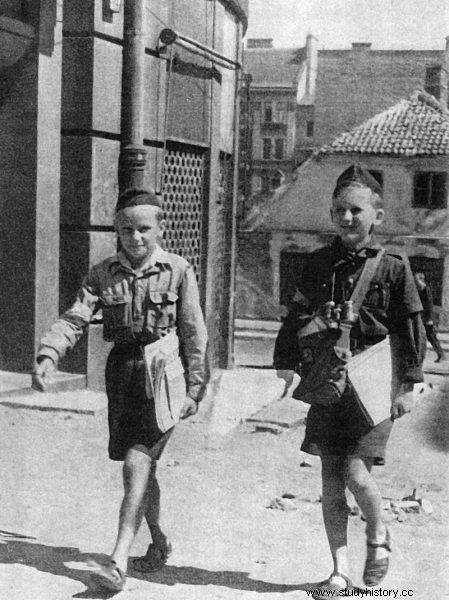
The Scout Field Mail in the Warsaw Uprising
German tanks were approaching Kiliński Square. Thirteen- or fourteen-year-old kids were throwing bottles full of gasoline on tanks. In most cases, they managed to burn a tank.
Around August 18, the Germans released a tank loaded with explosives to Kiliński Square. Our boys did not know that it was such a sinister trick on their part. After children and teenagers aged fourteen or eighteen approached the tank with great enthusiasm, there was an explosion that caused a lot of damage to people, especially among young people .
It even happened in Mokotów that a mother brought two of her sons to the ward - eleven and twelve years old - unable to keep them at home. They just survived.
Death is not everything
It was not the risk of death itself that was the biggest problem with the participation of children in the uprising. At that time, it was just as easy to die without doing anything at all, or in the role of a liaison or intelligence officer. The basic problem lay in the psyche of the "little insurgents" who were certainly excellent in combat, but at the same time this "combat" way of solving all problems led them to very disturbing tracks.
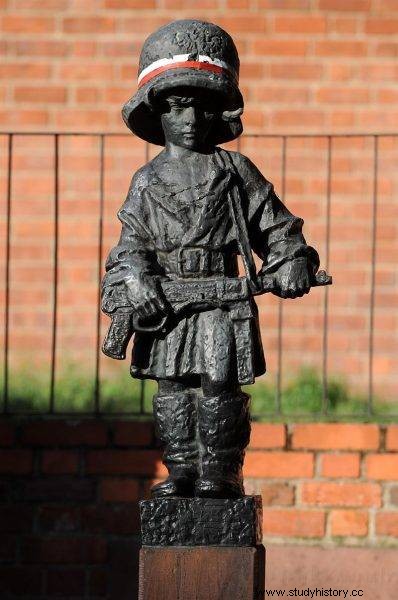
Monument to the Little Insurgent in Warsaw
- You cannot treat minors as a monolith - says psychologist Elżbieta Supryn. - We assume that from around the age of fifteen, a young person experiences the same emotions as an adult , and can perceive facts as she does. The trouble is, he usually can't deal with them yet. When a teenager is placed in an extreme situation such as war, he suppresses his fear with excessive bravado and aggression.
It works on the principle - no one can see that he is afraid; no one, not even himself. This attitude is well known from cinema, literature or simply from life - the weakest individual in the group is at the same time the most aggressive, and often just plain cruel. According to Dr. Supryn, if the extreme behavior does not offend in an extreme situation, then after it ends, the young person may have serious problems returning to normal conditions.
- It all depends on the individual, but as a rule he becomes a depressive, withdrawn person - adds the psychologist. - He also has a lot of trouble distinguishing between right and wrong . How could he not, when on the one hand they tell him that killing is objective evil, on the other hand they give him a rifle and say that sometimes killing is good? This experience can take its toll in later life.
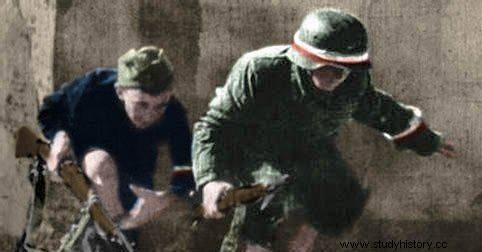
Youth in the Warsaw Uprising
Command realized this. It is for this reason that even adult scouts, over the age of 18, organized in Assault Groups, were directed primarily to a transport diversion - a difficult, very important task, requiring a lot of professional knowledge and providing the boys with the necessary adrenaline, but at the same time not requiring excessive contact with weapons, killing.
But it was pure theory. Kedyw dispatch units, or, to put it simply - enforcers - were mainly recruited from sixteen-year-olds. And when you read their memories today, they almost perfectly match Dr. Supryn's diagnosis. They were aware of the seriousness of the situation, they knew perfectly well what they were fighting for and what the rules of the game were, but at the same time they were still boys who were still playing war in their own way - the troops competed with each other, who would get more crosses, so in fact how many he will kill people.
Józef Roman Rybicki, the then head of the Warsaw Kedyw, was gloomy about this phenomenon:
The idea of fighting absolved everything, but did our soldiers see the purpose of Kedyw only in ideological works? Will this Kedyw fight idea keep our troops in the future? Could the weak, vulnerable units be affected by the time of the entire work in Kedyve, or did this external form:liquidations, sudden actions - sometimes obscure the essential content of the fight against Germany? Didn't the thirst for adventure, the unknown world of impressions pull the soldiers too far, until they could drag them to the bottom of vice?
When he learned how to make a gun, when he learned how to slightly drop the trigger of a pistol and shut his mouth forever to his opponent, did he not learn and get used to it too recklessly on his own, arbitrarily, in your own interest, to put your finger on the pistol trigger? Did he not eliminate his personal enemies, or did he gain some fortune with weapons?
White icon, black icon
The Warsaw Uprising probably lasted too short to deform the psyche of the child soldiers participating in it for good. Apart from big cities, however, it was sometimes different. Teenagers who had been familiar with weapons for several years in forestry units, very often at the end of the war, or right after it, turned into common bandits .
A common problem in provincial post-war schools was students carrying weapons and resolving conflicts with their help, and those who somehow avoided it faced psychological turmoil for the rest of their lives. It was sometimes a tragic end, as in the case of Stefan Dąmbski, known for his famous memoirs published under the title "Executor", who shot himself in the head after several decades of scratching his wounds.
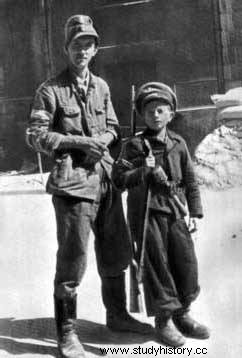
Gendarmerie soldier and "helper"
It is a situation well known from modern times, when, according to UN data, 300,000 children participate in armed conflicts in 30 countries around the world. And that's 300,000 very cruel children.
It's very easy to turn children into soldiers. They are easy to kidnap, they are cheap to maintain, they adapt more easily to new conditions, they learn to fight faster. Children are easier to manage than adults and they are more easily influenced. They are more obedient and submissive than adults, they do not rebel against commanders, they have no brakes, therefore it is easier to persuade them, provoke or force them to commit crimes:killing, torture, rape, plunder and plunder –Writes the cultural anthropologist Joanna Wojtarowicz.
Of course it is difficult to make simple comparisons between juvenile insurgents and their peers from Sub-Saharan Africa or South America . Nobody forced them to fight - on the contrary, they tried to be distracted from direct actions.
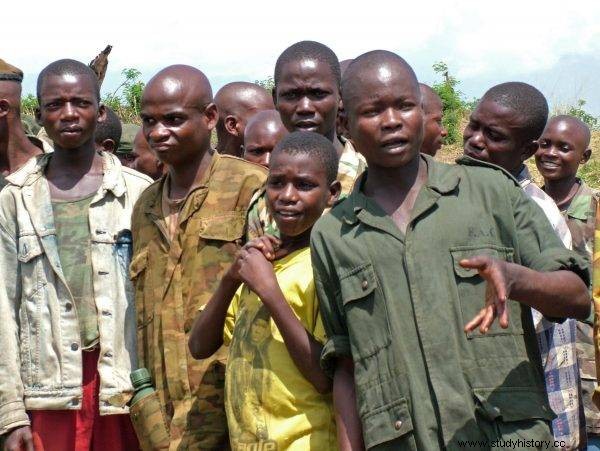
Demobilized child soldiers in the Democratic Republic of the Congo
Their participation was entirely voluntary and was as a rule noble. The child, however, remains a child. Even if they were not used deliberately, just allowing them to take part in a fight had something to do with taking advantage of the child's ignorance and naivety .
Just listen to the memories of "Klara":
We were young then, and our approach to death was different. We did not assume at all that the uprising would collapse, we believed that it would continue until we were victorious. Nobody believed he could die. Even if they all die, it doesn't concern me, everyone thought. Somehow we didn't realize it. And yet death was everywhere .
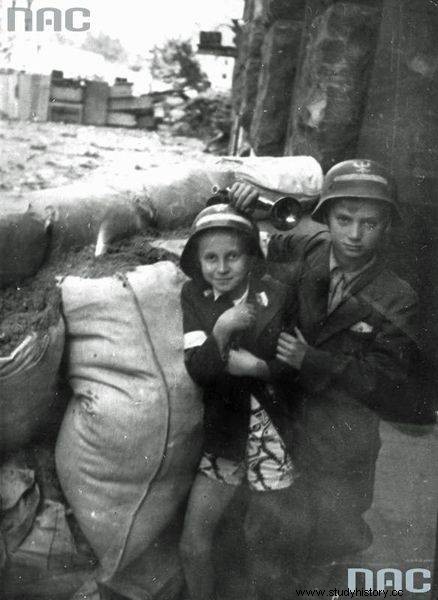
Teenage participants of the Warsaw Uprising
It is therefore appropriate to at least consider whether our unambiguous admiration for the icon of the "Little Insurgent" and the simultaneous, equally unambiguous opposition to the "Little Insurgents" from Uganda or Sierra Leone does not have a large a dose of hypocrisy. This was the question Maria Piotrowska and Błażej Popławski asked themselves:
Most Poles intuitively sense sympathy, compassion and admiration for the Little Insurgent (...). They are made heroes, and their sacrifice is seen as proof of maturity and patriotism. On the other hand, the photo of a black teenager with an AK-47 in his hand, which is one of the gloomy icons of 20th-century Africa, is frightening and proves the barbarity of the inhabitants of the jungle south of the Sahara. These two stereotypical images - a Warsaw insurgent with a bottle of gasoline and an African child with a Kalashnikov - are two depictions of child soldiers taking part (voluntarily or under duress) in wars waged by adults .
So heroism or barbarism?
